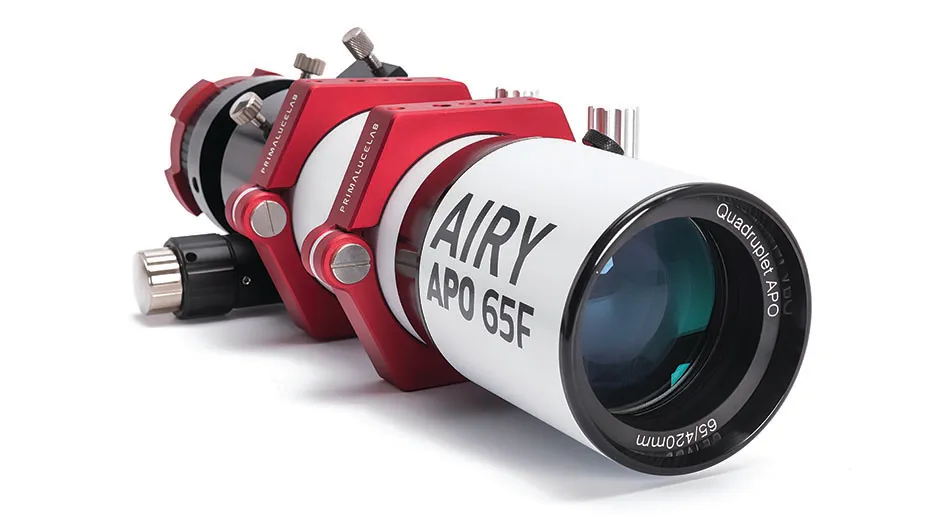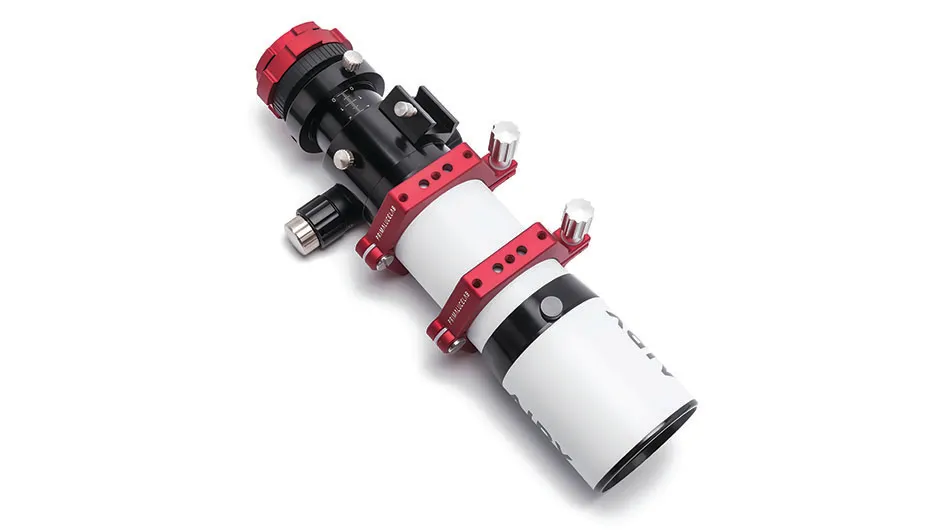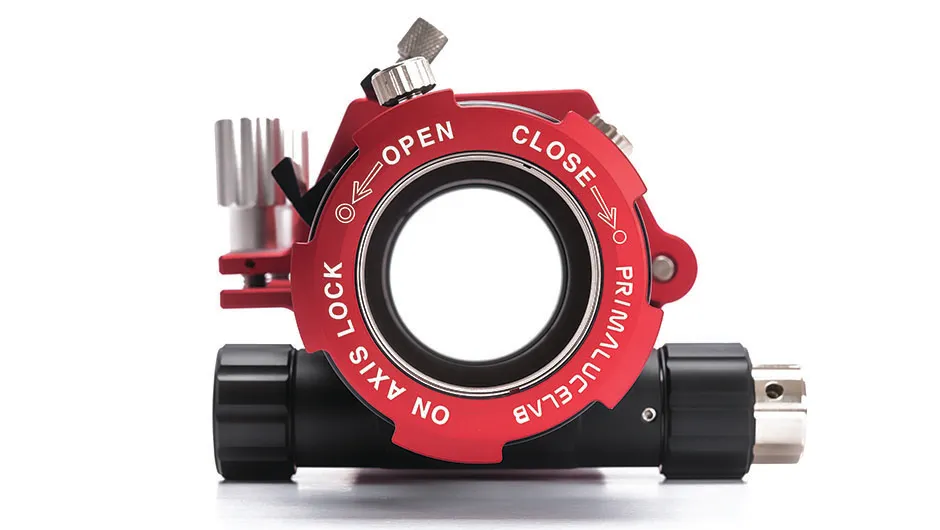Many regard refractors as the perfect design of telescope, giving high-contrast views thanks to the lack of the central obstruction found in mirror-based instruments.On the downside, large refractors are expensive and can be unwieldy.PrimaLuceLab’s Airy APO 65F is small enough at 2.5 inches to be both affordable and manageable.
One negative effect of using a lens is chromatic aberration, where the main lens is unable to bring all visible wavelengths to a common focus, resulting in colour fringing.
The Airy APO 65F uses a three-element FPL-53 glass objective to address this issue.
A fully colour-corrected telescope is termed apochomatic, APO for short.
The 420mm focal length makes this a relatively fast (f/6.5) instrument.
Coupled to a Canon EOS 6D full-frame DSLR, we produced images covering a 2.1x1.7° rectangle of sky, an ideal size for extended objects such as star clouds, open clusters, nebulae, and galaxies like M31 and M33.
Fast instruments can suffer from coma, which leads to distorted stars towards the edge of frame and is normally addressed by attaching your own field-flattener between scope and camera.

The Airy APO 65F possesses a permanent flattener made from FPL-53 glass, fitted internally.
Testing during the summer gave us a good choice of star clouds and large, expansive nebulae to pick from.
To a large format imaging sensor objects such as the North America Nebula in Cygnus, NGC 7000, provide a tough test subject, with a field of view covered with stars right across the frame.
Using our Canon EOS 6D DSLR, the Airy APO 65F delivered some excellent results: stars at the centre of the frame appeared pin sharp, with only the slightest hint of distortion creeping in towards the extreme corners.
Our large sensor test produced only slight vignetting in the corners of the image.

Easy grip, easy grasp
The scope uses what’s called an OnAxisLock mechanism to hold equipment into the focuser drawtube.
This is an alternative to the traditional thumbscrew locking found on most focusers and works by having a large, easy-grip locking ring that causes an internal collar to tighten around the barrel of whatever has been inserted when tightened.
A 1.25-inch OnAxisLock adaptor, using the same principal, is supplied to complement the built-in 2-inch version.
The mechanism’s design means that anything locked in place will be perfectly on-axis with the main telescope.
The grip-ring is chunky and usable even when wearing gloves, but we found that the system tends to rotate the inserted equipment during tightening.
The focuser itself allows full 360° movement, so this isn’t too much of an issue.
We also found that barrels with recessed sections needed special care, because the reduced diameter of the recessed ring didn’t always grip properly with the 1.25-inch adaptor.

Cancelling creep
A dual-speed hybrid drive focuser merges Crayford-style friction focusing with the direct action of a rack and pinion focuser, and gave us one of the best focuser experiences we’ve ever had.
The movement was smooth, responsive and direct, with the 1:11 fine focus knob producing no backlash.
The focuser design eliminates the creep that sometimes occurs when using a heavy camera at a steep angle, which can cause the focuser to extend.
We couldn’t budge it even when reasonable manual force was applied.
Using our own diagonal and eyepieces, the Airy APO 65F delivered high-contrast views free from any colour fringing.
The bright gibbous Moon, viewed at 84x magnification, appeared beautifully detailed.
We could make out the 6km-diameter crater Hadley C quite convincingly, but the nearby Hadley Rille escaped us.
At low magnification, we were delighted to see the Moon and stars visible in the field of view.
With a 20mm eyepiece giving a magnification of 21x, it was wonderful to sweep along the Milky Way’s rich star fields.
The stars really do look vibrant with the scope’s superb contrast.
This is a great grab-and-go scope with some nicely thought out features.
It is supplied with a set of Prima Luce Universal System (PLUS) tube rings for mounting, but you’ll also need a dovetail.
Its short focal length isn’t particularly demanding in respect of its mount, unless you intend to use it for seriously long exposures.
Biased towards wide-field, low-power views, this is a scope best suited to stunning deep-sky vistas.

Objective triplet lens
Refractors make superb deep-sky imaging instruments because of their contrast performance.
To get the best results the optics need to bring all colours of light to focus at the same point.
The triplet objective lens at the heart of the Airy APO 65F is designed to do just that.
Using three FPL-53 glass elements, all colours are brought to a single focus leading to a clean image that is free from unwanted colour fringing.
FPL-53 is an optical material that attempts to replicate the exemplary optical properties of fluorite, a material that is easily damaged, expensive and not particularly environmentally friendly.
Stronger, cheaper and greener alternatives are now popular.
The FPL-53 name indicates that the glass is made from a fluorite-lead compound (F = fluorite, P = lead) with a low refractive index (L) and is the 53rd member of the material’s development family.
In use, we didn’t encounter any colour fringing even around bright extended objects, and found the optical qualities of the scope to be excellent.
Hybrid drive focuser
The hybrid drive focuser combines the qualities of a Crayford-style focuser with that of a lockable rack and pinion.
This produces a fast, smooth focusing action that won’t slip with a heavy camera attached at high angle.
A 1:11 fine-focus knob ensures you achieve the accurate focus with ease.
PLUS tube rings
The substantial and beautifully machined PLUS (Prima Luce Universal System) support rings clamp the scope for mounting.
Three pre-threaded M8 female screw-holes and two head-recessed non-threaded holes are provided on the top and bottom of each ring.
This gives excellent flexibility for both mounting the scope on a dovetail as well as attaching extra kit on top.
Integrated field-flattener
Short focal length, wide-field instruments are great for covering large sky areas, but are prone to distortions noticeable at the edge and corners of the imaging field.
This can be a big problem if you’re using a camera with a large sensor.
The Airy APO 65F contains an internal field-flattener made from FPL-53 glass.
OnAxisLock
The Airy APO 65F has a serious camera connector in the shape of the OnAxisLock system.
The telescope offers a 2-inch fitting as standard and a 1.25-inch adaptor is supplied.
A locking ring ensures the barrel of attached equipment is held securely and exactly on the central optical axis of the scope.
Optical tube
This scope is built like a tank.
The 2.3kg, 350mm-long tube is made from aluminium, and feels incredibly solid and well-constructed.
There’s an extending dew shield and the inside of the tube has been flocked to help increase contrast.
Vital stats
- Price£793.00
- Aperture65mm (2.5 inches)
- FocalLength420mm (f/6.5)
- Weight2.3kg
- Supplier 365Astronomy
- Telephone 02033845187
- Websitewww.365astronomy.com
This review originally appeared in the September 2017 issue of BBC Sky at Night Magazine.
